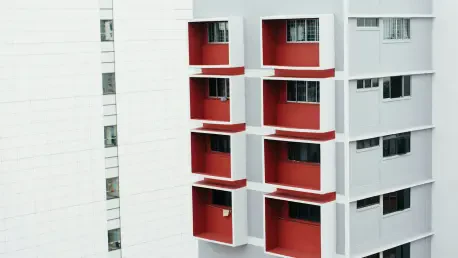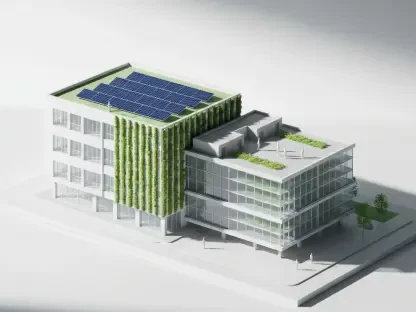In the current landscape of the UK’s housing market, the Build-to-Rent (BTR) sector has emerged as a dynamic and influential force, capturing considerable attention with its impressive growth. Even amidst the backdrop of economic fluctuations and geopolitical uncertainties, the BTR sector has continued to expand, marking a significant milestone this year with an investment surge reaching a remarkable £6 billion. This achievement signals the sector’s evolution from a niche investment area into a mature, diversified segment of the housing market. Since earlier this decade, the number of operational BTR units has more than doubled, exceeding 130,000. Furthermore, with over 56,500 units actively under construction and an additional 126,000 in planning stages, BTR is poised to reshape the housing market landscape significantly.
Diversification and Regional Expansion
One of the most notable developments within the BTR sector is its diversification away from traditional urban models toward more varied offerings, including single-family rentals (SFR) and co-living schemes. This shift has expanded its appeal to a broader demographic, aiding its transition from a niche segment to a mainstream player in the UK’s housing market. Not restricted to London anymore, regional cities have emerged as pivotal contributors to the BTR boom, accounting for a substantial portion of the construction pipeline. Specifically, approximately 60% of the BTR units currently under construction are located outside the traditionally dominant markets of London and Greater Manchester. Cities like Birmingham have taken center stage, with significant developments like Moda’s Loudon’s Yard and Cortland’s Broad Street scheme driving growth and showcasing the changing geography of BTR investments.
Institutional interest in SFR has played a pivotal role in this expansion. Over the last two years, the investment in the SFR segment reached an impressive £1.9 billion each year, far surpassing previous financial averages and indicating a robust demand from institutional investors. Although SFRs currently constitute around 10% of operational BTR units, they have dominated investment volumes, accounting for 38% during this period. This points to a growing confidence in SFR’s potential to yield stable returns. Moreover, the trend of increasing stabilized asset transactions indicates an evolving market. Significant transactions, such as Ridgeback’s purchase of Equipment Works and the joint acquisition of Birmingham’s Allegro by QuadReal and Realstar, have set new records in multifamily investment volumes, further boosting the BTR sector’s momentum.
Market Dynamics and Future Prospects
Despite experiencing some moderation in rental growth last year, a resurgence in the rental market is projected, driven by a persistent supply-demand imbalance and recent legislative changes, such as the Renters’ Rights Bill. This resurgence is anticipated to push rental prices higher as supply struggles to keep pace with demand. Simon Wilson of Lambert Smith Hampton (LSH) notes the sector’s resilience and adaptability in the face of economic uncertainties, underscoring the significance of continued growth beyond London and the sustained demand for SFRs. The increasing volume of trades involving stabilized assets is also a noteworthy trend, fueled by substantial institutional investments and a maturing real estate market.
Looking ahead, the trend of forward purchases and operational transactions is expected to strengthen as the BTR sector continues to develop. This trend is indicative not only of the sector’s growth but also of its maturity in attracting long-term investments. These dynamics suggest a promising future for the BTR sector, with its influence likely to extend further across the housing landscape. As institutional capital flows steadily into this sphere, the market appears set to embrace the evolving demands of modern residents. From shifting demographic preferences to new legislative landscapes, the BTR sector seems well-positioned to solidify its role as a pivotal player in the UK’s housing market.
Evolving Landscape and Conclusion
The Build-to-Rent (BTR) sector is diversifying from traditional urban offerings to include single-family rentals (SFR) and co-living spaces. This shift appeals to a broader demographic, helping BTR transition from a niche market into a mainstream housing player in the UK. Previously dominated by London, regional cities are now crucial to the BTR surge, with around 60% of new BTR units under construction beyond London and Greater Manchester’s typical markets. Cities like Birmingham are now prominent, with major projects such as Moda’s Loudon’s Yard and Cortland’s Broad Street scheme highlighting the evolving geography of BTR investments.
Institutional interest has significantly boosted the SFR market, with investments hitting £1.9 billion annually over the past two years—far beyond previous averages—indicating strong confidence from institutional investors. Though SFRs account for about 10% of operational BTR units, they represent 38% of investment, suggesting stable returns potential. Major transactions, like Ridgeback’s Equipment Works purchase and QuadReal and Realstar’s acquisition of Birmingham’s Allegro, set new multifamily investment records, propelling the BTR sector forward.









